
PART ONE: YOU ARE THE MEDIA YOU EAT
PART TWO: HOW TO BALANCE YOUR MEDIA DIET — NUTRITIONAL MEDIA
PART THREE: WHY WE LIKE THINGS THAT ARE BAD FOR US — THE CHEESECAKE THEORY
Whilst not designed as a planning tool, the pyramid can help apply a set of qualitative filters to media and communication planning.
Strategic communications planning considers context, channel effects, historical profitability, and numerous other criteria beyond target audience, cost, reach and frequency when developing a communication and investment plan.
The object is to leverage different communications tools appropriately to maximize their integrated effectiveness, rather than settling for the media efficiency of reaching the target audience as cheaply as possible, which could be established by a spreadsheet — or an algorthim.
There are a number of ways to understand the media pyramid’s primary vector. It was designed to balance media consumption to maximize reported psychological wellbeing, with media at the top being toxic. Media near the top makes people feel bad after extended consumption and media towards the bottom tends to make people feel better. Since we process information differently depending on context, it follows that medium has an impact on the efficacy of brand communication.
Additionally, it maps well against a spectrum of passive to active consumption [as we discussed in PART THREE] and also to attention levels and quality [which includes viewability, context, modality and anything else relevant to the effect]. The level and quality of the attention being bought is an important consideration that the cost of impressions doesn’t necessarily reflect. The quality of attention isn’t properly priced.
The primary thesis of my book Paid Attention is that attention is the determinant resource being bought, sold and allocated in advertising exchanges between companies and people. When framed this way it creates a number of novel ways of thinking about the advertising value proposition and how consumers pay for content and experiences, either fully, or partially, with their finite attentional resources.
For example, for as long as their has been advertising, there have been concerns about clutter [which is the charming term used to refer to ‘other people’s advertising’]:
“Advertisements are now so numerous that they are very negligently perused, and it is therefore become necessary to gain attention by magnificence of promises, and by eloquences sometimes sublime and sometimes pathetic.”
— Dr. Samuel Johnson, 1759
But when reframed around attention, we can see that today’s conversation is not the same old complaint.
Media consumption in the USA has plateaued at an average of 12 hours per person per day. According to eMarketer, “by 2018, growth in total time spent is expected to be a negligible 0.1%”. We can consider that a proxy for peak attention.
There just isn’t any more time left to consume additional media or advertising. Additionally, the rise of adblocking and other avoidance behaviors, including the growth of non-commercial media options, suggests the attention market in the USA is saturated — these are market corrections.
Nonetheless, the amount of impressions being delivered has grown exponentially. It’s hard to give an exact number now but that last time Comscore reported the data there were 5.3 TRILLION digital advertising impressions served in the USA in just one year, which is a staggering, almost abstract, figure.
The finite attention cake is being sliced ever more thinly, it seems.
All Impressions Are Not Created Equal
We now know a significant portion of digital impressions aren’t real.
According to Google 50% are not viewable [a non viewable impression is an oxymoron], a third is lost to fraud, more than a quarter of the USA online audience uses an adblocker &c.
More generally, it is obvious that an impression delivered for the requisite 2 seconds online or in the flowing stream hoping to attract a thumb is not the same thing as watching a 30 second commercial in a darkened movie theatre. The attention level is clearly different, as is the context, the modality of reception, the channel effect, the environmental resonance and so on.
The fungibility of impressions is a convenient fiction that allows for trading and cross media comparisons but it’s obviously not true. Whatever seeing a television commercial does, it clearly isn’t the same thing as a print ad, whatever that does, if the same person views both.
As it follows consumption and ease of trading, media money tends to focus in areas of the pyramid that make people feel bad, especially online, which now claims the majority of spend.

However, a category of spend such as “digital” includes a vast number of options and types of brand communication, from search [arguably very different since it fulfills demand based on requests] through email marketing and digital display, across network on on retailer sites. Currently however, more than 2/3 of all digital media spend goes to Google and Facebook. Amazon however has built a considerable advertising business [$2 billion and growing] because it’s where the vast majority of things are bought online and its share continues to grow.

Obviously different brands and campaigns have different objectives that need to be considered and not every brand or product are sold on Amazon.
Further, communication planning factors in all options not just paid media. Factoring in direct mail spend, which is significant, and breaking out other elements, changes the percentage split and gives some additional granularity…
…but this estimation from MAGNA dramatically underestimates DM spend as reported by the Direct Marketing Association, which pegs it between $45bn and $50bn, making it potentially the biggest medium by spend.
Additionally, the qualitative aspect of media selection must be balanced against ROI, long term profitability, cost, reach &c.
Recent Radiocentre/Ebiquity research suggests that some of the smaller media are more effective than surveyed advertisers believe, which perhaps partially explains why they receive disproportionately low spend overall.
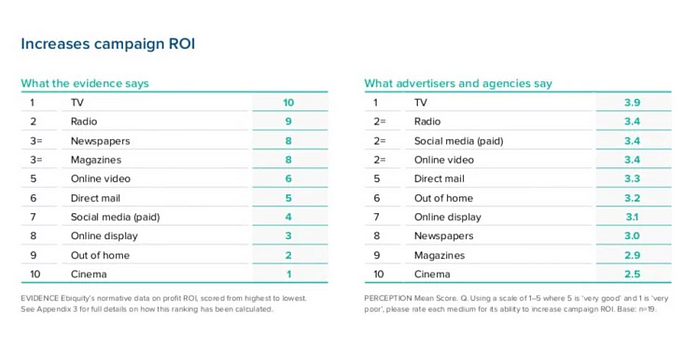
Marketing expense budgets are more than just media and, according to Gartner, the biggest allocation is marketing analytics, which is both quite surprising and a useful additional view, reminding us that things look quite different to CMOs than they do to their agencies.

These conflicting data are good reminders that all such figures are only ever estimates and should be considered directionally.
As with the Media Pyramid allocation of time, the suggested budget breakdown is just a starting point for consideration. It is not, nor can it be, as simple as a breakdown by channel, but rather by context and impact as much as possible.
The hope is that marketing money will be allocated with more intention to the quality of attention and context, the effect on annoyance and avoidance, the emotional and business impact and the brand effect of the environment, rather than simply the reach, frequency and cost.

Media options at the top of the pyramid where context is most abandoned in favor of efficient targeting and is fastest in building reach and this works well for sales activation.

Media options towards the bottom, where the media placement is very or entirely context dependent and is slower at building reach and thus works better for long term brand building.
Some channels are simply better at different communication tasks and there is corroborating evidence that the pyramid typology maps well against activation versus long term brand effect.
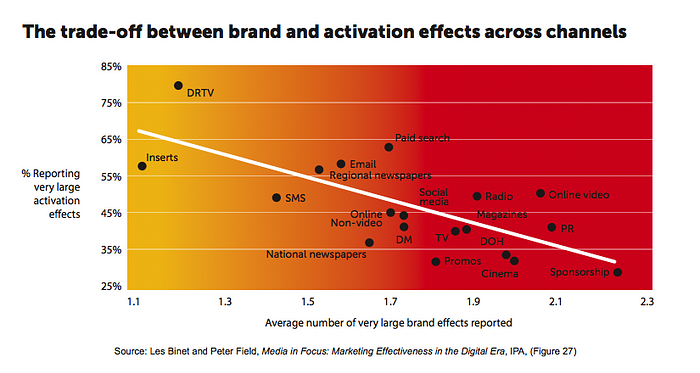
Balancing the different strengths and creating integrated plans is dependent on research and most media research comes from the medium trying to sell itself so must be considered critically.
There is little to no impartial media research on advertising effectiveness — who would pay for it? [There is a small amount of academic research but not much.]
That said, all research should be considered critically and methodologies matter. Consider this a form of media [planning] literacy, being able to use research as well as possible, because the alternative [to just do whatever you feel like based on nothing] is not strategy — it’s gambling with vast sums of your company’s or client’s money.
Efficacy and Ethics
Advertising has long been suspected of using shady tactics to enhance persuasion, especially following Vance Packards Hidden Persuaders and the outcries about subliminal advertising effect. There is an ethical parameter to channel choices because every dollar spent supports the media property being utilized. We will explore this more below.
With those caveats, let’s consider the pyramid.
PLANNING WITH THE PYRAMID
RED: INFO-TOXIC-ATION | Media that brokers in falsehoods and divisive speech should be avoided
We process information differently depending on context. These media publish falsehoods and/or hate speech and sell “snake oil” products, providing a toxic environment for brands.
No doubt many consumers of “red triangle media” believe what they are reading, even when it is demonstrably false and designed to incite division, abuse and harassment, or under investigation as misleading or even dangerous.
This is ultimately bad for the audience and bad for brands trying to establish trust in their messaging against the whole market, most of whom do not consume these media, because non-consumers of them regard them with extreme suspicion and antipathy.
“Brand safety will define digital advertising in 2018”
Brands have been discovering that their advertising is appearing in environments that ‘do not reflect their values’.
Due to the complexity of the media supply chain, brands may not know which websites their advertising is appearing on and on television they may not know what is being said on programs their commercials appear in.
As the Overton Window opens ever more widely, toxic media has increasingly championed extreme opinions in the hopes of attracting attention and thus revenue.
This was the foundation of the information campaign by Sleeping Giants, which has highlighted which brands have advertising being programmatically served alongside the “bigotry, sexism and propaganda of Breitbart, which was masked as news”.
How and where brands spend their money, the kinds of content and media they are sponsoring, says something about them and affects the impact and efficacy of all advertising in that environment.
In response to the Sleeping Giants campaign, nearly 4000 brands have pulled their advertising from the site.
In the UK, the “Stop Funding Hate” organization has been campaigning for advertisers to reconsider their support of the Mail Online / Daily Mail [and the Sun and Daily Express] because of “the way [those newspapers] were using hate and division to drive sales” and pushing for a more ethical approach to advertising that incorporates context.
They highlight articles to advertisers that seem especially problematic and divisive, such as a recent column “targeting British Olympic hero Tom Daley, which was widely seen as homophobic”. It has led to a number of advertisers withdrawing their advertising.
Fox News has been subject to numerous campaigns focused on their advertisers in response to statements and behavior of their of their hosts. The recent outcry concerning Laura Ingram’s show following a tweet where she mocked a survivor of the Parkland School shooting for not getting into colleges. Most of the top advertisers have said they will no longer support the show because of comments there were not in line with their values, and the host went on an unexpected break. However, following the ‘vacation’ she returned and earned the best ratings her show has ever seen and ultimately many brands returned, seemingly because ratings mean more than ‘their values’.
Brands pulling advertising to avoid damage by association with toxicity is perhaps testament to the fact that appearing in such media should be more closely considered in the first place and that if they don’t know where their ads are appearing, perhaps they should.
ORANGE | Media that is passively grazed for long periods, through a single algorithmic or broadcast stream
In some ways it is this very passivity which allows the content to interrupted by advertising as we sit on the couch or scroll the stream.
Brand and consumer data safety concerns have challenged the incredible growth of social and digital display media of late.

Facebook is trapped between a rock and a hard place, trying to defend its efficacy as a medium to influence consumer behavior whilst at the same time downplay its impact on elections. Meanwhile, its historic handling of data and the subsequent unregulated political interventions have recently triggered the#deletefacebook movement and trust in the product and its share price have dropped precipitously. As discussed previously, passive consumption of the newsfeed makes people feel bad.
Abandoning Facebook would be unlikely and probably unwise for many marketers, especially smaller ones, but the promises of micro-targeting at scale no longer seems compelling and indeed have yet to be effetively substantiated. Recommendation is to use it broadly, as led by P&G, as a paid broadcast media platform and forget about organic reach since it’s been effectively 0% for years — but with caution.

Youtube is another social medium making a play for brand budgets, and has done a lot of work to re-build trust with advertisers around brand safety, but continues to be plagued with safety issues that lead to advertisers pulling their spend.

In general, we can say that programmatic digital advertising is probably getting too much media money, creates brand safety and efficacy concerns and that when using it as a communication tool, quality and context should be key considerations, above cost.
There may be structural incentives driving overweighted media allocation into programmatic. I’ll leave this here and we can move on.

Online video creates low emotional brand response especially compared to other video media partially due to being a low attention environment:
“the small screen, fleeting attention and often distracting context for consumption lead to it performing dead-last in terms of generating an emotional response.” — Mark Ritson

Cheap programmatic provides no guarantees about where brand advertising will appear, hence rendering strategic [rather then just safety] considerations of context somewhat moot to boot.
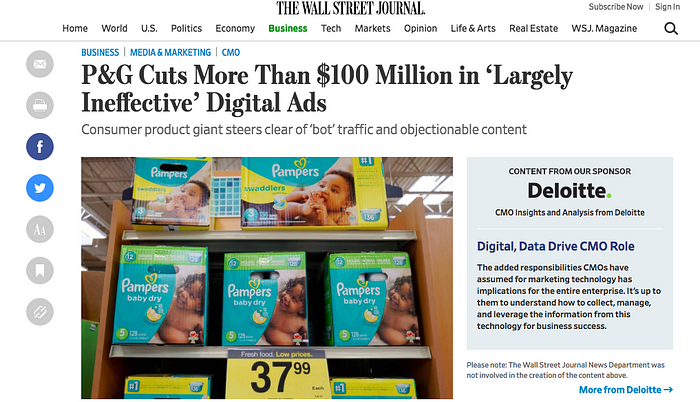
Broadcast news has been a rating recipient of the current political climate because actors have been focused on attention hacking.
“Trump told us, ‘I’m going to get in and all the polls are going to go crazy. I’m going to suck all the oxygen out of the room. I know how to work the media in a way that they will never take the lights off of me.’”

Increased eyeballs means increased advertising revenue, at least until boycotts triggered pullbacks. But brands and plans should consider the environment that news provides as well as ratings. News is very rarely positive, because of negativity bias and increasingly concerning to many in the current political context. A survey from Oxford University’s Reuters Institute found that sixty per cent of respondents said news “can have a negative effect on my mood”.
Appearing in breaks between natural and manmade disasters is a context choice. It might be a great choice for insurance advertising, for example, but perhaps less so for other brands, especially those that have anchored their brand in positive higher order emotions.
A question to consider is how different it is in terms of brand safety to appear on broadcast news broadcasts about a school shooting as opposed to next to a disturbing video online.
Another factor to consider is fame and creative excellence in relation to media choice. The most creatively awarded advertising is almost always film, due to a variety of factors, and the most awarded work drives multiples on media spend in terms of growth.
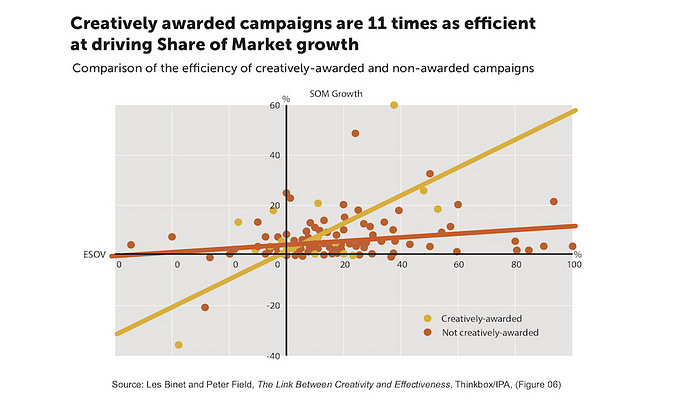
YELLOW | Direct marketing [personal communication] and broadcast television work together
This section houses two of the biggest categories of spend, direct marketing [mail and email] and broadcast / cable television [DR and brand].
These two channels classically work well together, with broad television creating the socio-cultural stimulus that direct mail converts.
Television continues to the most effective channel and cheapest reach if you can afford it at scale.
[Old joke: Media Planning 101. Can you afford TV? Do that. If not, do something else.]

But television especially in the USA has become highly interruptive with ever increasing ad loads which makes viewing annoying and pushes viewers towards skipping and non-commercial options, especially cord cutting behavior which is accelerating even faster than predicted.
You can tell it’s saturated beyond the ability to work effectively when broadcasters start to voluntarily reduce their ad loads.
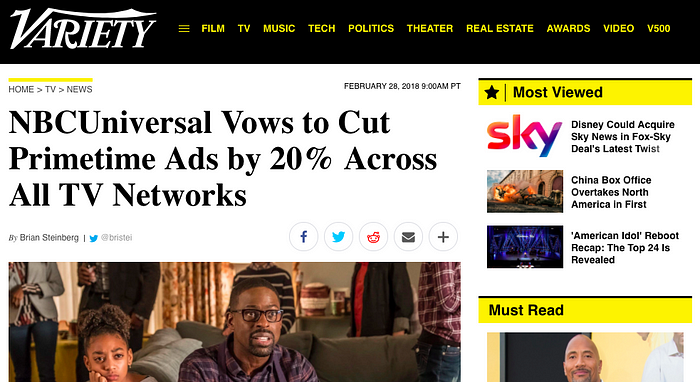
Obviously television is more fragmented that ever and viewing habits are changing. People who used to watch TV now sometimes watch Netflix. But in the absence of a robust alternative that operates at a cultural level, money continues to flow to the ever declining audiences of broadcast television and SuperBowl spots keep getting more expensive despite reaching less people.[That trajectory can’t continue indefinitely.]
Regardless, TV sales are down [almost 8% in 2017] and viewership will continue to decline in face of broader competition from digital players who have ramped up their content budgets to dwarf what broadcasters can afford. TV increasingly overindexes for older audiences with the median age for major broadcast shows now being over 50. That’s fine since they also have all the money, but unless commercial broadcast TV can recruit younger viewers, who have way more options and less entrenched habits, it’s going to face a slow continual decline.
Email is the digital channel that seems to produce the best ROI but maintaining an audience over time and not being relegated to spam folders means dedicating resources to content not just emailing catalogues and sales. GDPR in Europe created a trigger for many people to unsubscribe, if indeed they actually subcribed in the first place, as opposed to simply buying something from a retailer once. Open rates are useful here to gauge whether the subscriber base considers the communication of value and, as we established in PART TWO, managing an ever increasing amount email is a source of considerable stress and anxiety to many.
Direct mail is significantly more expensive than email but has some advantages in terms of impact precisely because it is a more reliable signal [due to the cost], especially since we now receive less personal [tree]mail.
70% of respondents said that mail makes them feel more valued (up from 57% in 2013) – and 70% said that mail gives those who receive it a better impression of the organisation (up from 55% in 2013).
To provide context, only 48% consider email believable. Mail is also seen as more likely to grab the attention of the recipient and be perceived as more secure and important. — The Value of Mail in Uncertain Times 2017
Mail is a higher attentional medium than email as it isn’t competing with the internet as directly when being consumed.
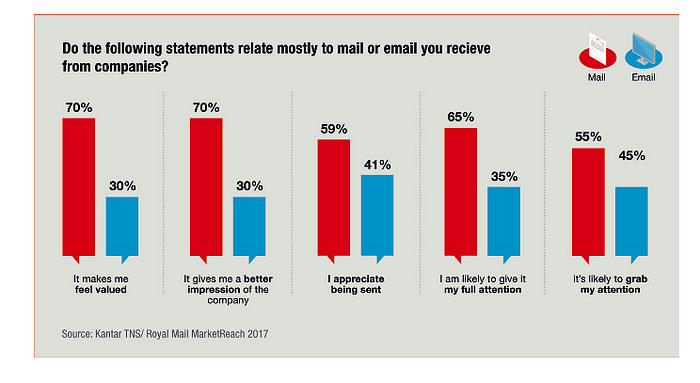
Direct mail response rates are understood and pretty well known. The reason you get so many credit card offers in the mail is because they work well enough to pay for themselves [selling expensive debt to the desperate is very profitable but that’s a different point.]
A Brand Science review of multi-channel campaigns concluded that when mail was included in the marketing mix, campaigns had 12% bigger ROI than those without mail. — ibid.
BLUE | Media in which one chooses specific content to consume or is otherwise actively engaged in the content.
Almost by definition, these media do not accept commercial interruption but there are still opportunities for brands here.
Cinema advertising has traditionally been considered slow and expensive reach but a channel that delivers stature and very high levels of attention so it tends to be used for high production value marquee advertising, especially as a launch medium for what becomes a tv/digital campaign.
As per other channels towards the bottom, it works better at long term brand effects. Recent research suggests it drives brand metrics more efficiently than TV or online video.

Earlier research suggests, as per the pyramid, that most brands are under investing in cinema/movie theatre from a ROI [rather than total effectiveness] point of view.

In brand metric terms, cinema, tv and magazines drive the greatest impact.
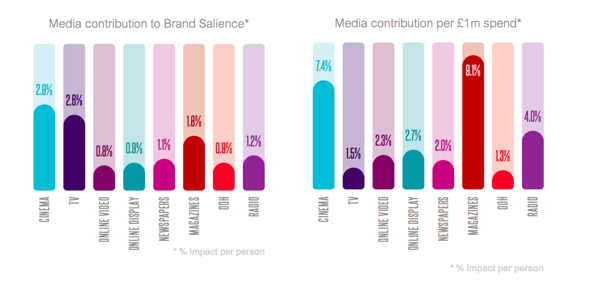
Product placement in, and brand co-promotion of, movies is significant across numerous categories especially as a way to mitigate ever increasing marketing costs for movies themselves.
Various telecoms brands around the world offer Netflix as a sales incentive and outside of the UK the BBC is a commercial broadcaster. A communication strategist will consider as broad a set of options for marketing as possible, not just what media can be most easily bought.
HOMO LUDENS
Gaming is arguably the biggest medium in the world, generating more revenue the the box office for movies several times over. Beyond some early experiments in advergaming, brands have largely been unable to find a role, due the complexity and lead times of video games.
However, competitive gaming has a become a spectator property known as esports and brands have begun to use their sponsorship playbooks to get involved.
BROWN: Media which increases our moral and intellectual capabilities
“What is the difference between seeing an ad on a billboard and seeing an ad in a magazine? The answer, in a word, is permission or, in three words, freedom of choice” Howard Luck Gossage [How To View Billboards]

As we saw above in the cinema research, magazines seem to under index on media allocation. There is some particular sense in which magazines are a permission based medium, both in terms of attention and advertising.
According to this research by the Association of Magazine Media, they are also the best channel at driving sales effect [but, as you are beginning to understand all too well, all media organizations think their medium is the best at something and have research to prove it].

There are clear qualitative elements in magazines’ favor, despite long term declines in sales.
Magazine retail sales have dropped from about 103 million in the end of 2014 to about 75 million by the end of 2016. Americans spent an average of 18 minutes reading magazines on a daily basis in 2010. This figure is forecast to decline to 15 minutes by 2018.
Although the time spent with magazines is declining, the number of magazine readers in the U.S. has slightly increased since 2012. The number of magazines in the U.S. has also stayed fairly constant over the years, varying from around 7,100 to 7,300 since 2008.
Magazines aren’t consumed on digital screens much [despite the best efforts of The Daily and Wired &c] and therefore represent a less fractured attentional opportunity. They are read usually for pleasure and edification, and don’t generally host arguments with strangers to pull attention away into outrage engagement.
The Radiocentre research speaks to the efficacy and under-utilization of radio. One notices, when one leaves NYC for a significant period of time, that NYC doesn’t have the same media consumption habits as the rest of USA. So, in NYC, no one drives and no agencies spend much time thinking about radio but everywhere else everyone drives everywhere to everything and listens to the radio all the that time.
[I was a guest a on KABC in Los Angeles talking about the media pyramid but you probably missed it.]
Podcast advertising has taken off since Serial and its iconic MailKimp sponsorship and is advertising that people seem to actually enjoy listening to, which one has to assume helps.

GREEN | Media in which we seek our best selves.
Here we are in the domain of arts, people and experiences. Word of Mouth is not a marketing channel — despite what some companies may tell you — it’s an effect of marketing activity and brand behavior.
Events and sponsorships are the key communication tools in this layer. Slow reach, contextually dependent, they are better at long term brand effects and should be considered as part of the mix, as indeed they increasingly are, although often as part of separate budgets and departments. Sponsorship spend is growing faster than other advertising or promotional spend.

It inherently leverages the power of context and association and as well as acquiring reach. Events and sponsorships are context dependent by definition.

Recently, we got to speak at an event in the Netherlands with Professor Byron Sharp, the author of How Brands Grow. Chatting afterwards, he was asked about media allocation and gave a very succinct response.
Paraphrasing, he said:
buy the largest number of the highest quality impressions against the entire buying market for the category for the lowest price.
But in that order, with quality coming first as the filter. Quality is a multivariate aspect of media, but hopefully the pyramid will help you build quality communication plans for your brands.
Using communication channels to their fullest extent means adapting ideas and creative work to best leverage the medium’s strengths and weaknesses. One filter of quality is the level of attention different media hold, which should change how brands utilize them.

Balancing all these considerations, making choices about how to allocate vast sums of money with the best chance of achieving a brands’s objectives, is what makes communication strategy a subtle, strategic craft.

